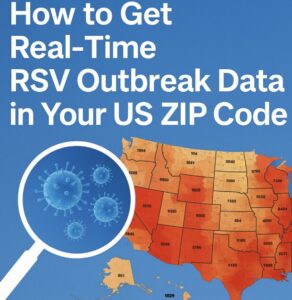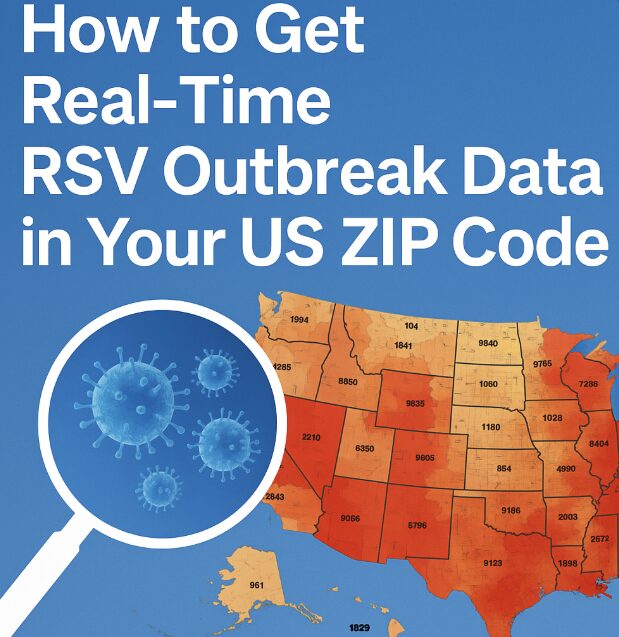With respiratory illnesses on the rise, especially among children and older adults, knowing whether Respiratory Syncytial Virus (RSV) is circulating in your area has become more important than ever. RSV can cause serious complications, and outbreaks often vary by region. Whether you’re a parent, caregiver, teacher, or simply health-conscious, accessing real-time RSV outbreak data by ZIP code can help you take timely precautions.
Fortunately, there are several trusted tools and platforms that allow you to monitor RSV activity down to your local ZIP code. In this blog post, we’ll walk through how you can use these platforms, what to look for, and how to stay safe during peak RSV seasons.

Why Knowing RSV Activity by ZIP Code Matters
RSV isn’t just a seasonal nuisance—it can lead to hospitalization, especially for infants and seniors. Real-time data can help you:
Decide when to avoid crowded indoor spaces
Adjust daycare or school attendance based on risk
Increase sanitation and mask protocols during local spikes
Better time doctor visits, vaccinations, or medications
Just like with flu or COVID, location-specific data allows for smarter, more informed decisions.
Tool 1: CDC’s Respiratory Virus Activity Tracker
The Centers for Disease Control and Prevention (CDC) offers a nationwide tracker that includes RSV, influenza, and COVID-19. While their data is mostly by state, they also partner with some local health departments for ZIP code-level insights.
To access this:
Visit the CDC’s respiratory virus activity dashboard
Select your state and then search by region or ZIP code
Monitor RSV trend lines, positivity rates, and emergency room visits
This tool is especially useful for spotting trends before they escalate.
Tool 2: HealthWeather.us (Kinsa Insights)
HealthWeather, powered by Kinsa’s smart thermometers and AI models, offers hyperlocal illness data, including RSV-like symptom spikes.
To use it:
Visit this real-time health map
Enter your ZIP code
View the current illness risk level and recent trends
While not RSV-specific, sudden increases in respiratory symptoms often correlate with RSV waves.
Tool 3: State and Local Health Departments
Some state-level health departments provide weekly RSV surveillance reports with regional breakdowns:
California, Florida, and Texas offer particularly detailed regional reports
Many include maps, positivity rates, and pediatric hospitalization stats
You can typically find these by searching: “RSV report [your state name]”
Bookmark your local health department’s respiratory illness page for consistent updates.
Tool 4: Google Trends for RSV + ZIP Code
A quick and underutilized trick is to use Google Trends to track local search activity for RSV-related symptoms:
Go to Google Trends
Enter search terms like “RSV symptoms” or “RSV child cough”
Filter by location and time (past 7 days or 30 days)
Check related rising queries for outbreak signals
This won’t give you clinical data, but it’s a good way to anticipate local awareness and concern.
Tool 5: Walgreens Flu Index (Includes RSV)
Walgreens offers a flu index based on prescription and clinic visits, and recently began tracking RSV activity through its clinical data partnerships.
Visit Walgreens Flu Index
Explore RSV-related trends in their seasonal reports
Some locations show ZIP-level illness clusters
This is particularly helpful if you’re located in urban or suburban areas with high Walgreens presence.
What to Do If RSV Is Active in Your Area
If you discover elevated RSV activity near your ZIP code:
Avoid indoor gatherings with vulnerable populations
Wash hands frequently and sanitize high-touch surfaces
Keep children home from school/daycare if they show symptoms
Monitor for fever, wheezing, or difficulty breathing—especially in infants
Consider masks in high-risk settings like clinics, transit, or crowded stores
If you’re a caregiver or live with someone high-risk, talk to your doctor about RSV immunization options, such as nirsevimab for infants or RSV vaccines for older adults.
How to Stay Informed Moving Forward
RSV doesn’t follow a strict calendar, and regional spikes can come unexpectedly. Set reminders to check:
CDC and HealthWeather weekly dashboards
Your state’s RSV updates every Friday (many states post weekly)
School district newsletters or alerts
And if you’re interested in receiving alerts, some platforms allow notifications via email or app. You can sign up for customized alerts on platforms like Kinsa Health.
With the right tools, you can act early and reduce the chance of infection in your home, classroom, or community.
